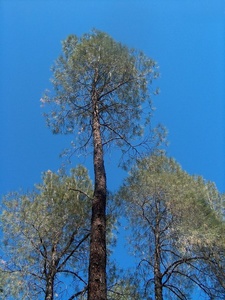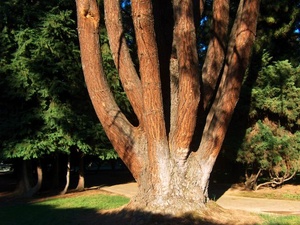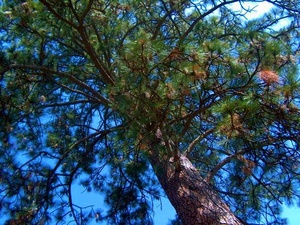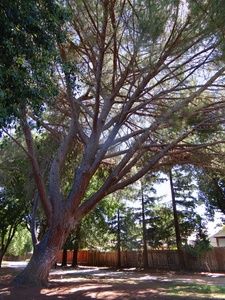Pine Trees are trees in the Pinus genus of the pine family. Other members of the pine family include cedar trees and spruce trees.
Pine Street in western Woodland is named for pine trees.
Native to Yolo County
 Gray Pines (Pinus sabiniana) display characteristically rounded tops, with mostly bare trunks below. Photo by queerbychoice.Gray Pine (Pinus sabiniana), also called Foothill Pine or Ghost Pine or (in the Patwin language) Tuwa, is a slow-growing evergreen conifer that is native to the Yolo County foothills, including the Capay Hills. It usually grows 30 to 70 feet tall and 10 to 30 feet wide, but it can occasionally reach 100 feet tall. In 20 years, it might grow to 20 feet tall. It prefers full sun or partial shade. It has very low water needs and grows only in dry areas. Its pine nuts, called sanank in the Patwin language, are an important component of traditional indigenous food and bear a strong resemblance to the Italian Stone Pine pine nuts commonly sold in grocery stores. Male and female cones are borne on the same tree. Gray Pine is ranked 4 out of 10 on the Ogrens Plant Allergy Scale, indicating that it has a fairly mild tendency to cause hay fever.
Gray Pines (Pinus sabiniana) display characteristically rounded tops, with mostly bare trunks below. Photo by queerbychoice.Gray Pine (Pinus sabiniana), also called Foothill Pine or Ghost Pine or (in the Patwin language) Tuwa, is a slow-growing evergreen conifer that is native to the Yolo County foothills, including the Capay Hills. It usually grows 30 to 70 feet tall and 10 to 30 feet wide, but it can occasionally reach 100 feet tall. In 20 years, it might grow to 20 feet tall. It prefers full sun or partial shade. It has very low water needs and grows only in dry areas. Its pine nuts, called sanank in the Patwin language, are an important component of traditional indigenous food and bear a strong resemblance to the Italian Stone Pine pine nuts commonly sold in grocery stores. Male and female cones are borne on the same tree. Gray Pine is ranked 4 out of 10 on the Ogrens Plant Allergy Scale, indicating that it has a fairly mild tendency to cause hay fever.
 Gray Pine (Pinus sabiniana) in the California State University Sacramento arboretum. Photo by queerbychoice.
Gray Pine (Pinus sabiniana) in the California State University Sacramento arboretum. Photo by queerbychoice.
 Yellow Pine (Pinus ponderosa). Photo by queerbychoice.Ponderosa Pine (Pinus ponderosa), also called Yellow Pine, is an evergreen conifer that is native along the far western border of Yolo County, in the Yolo County foothills (not including the Capay Hills). It usually grows 40 to 200 feet tall and 7 to 20 feet wide. In 20 years, it might grow to 40 feet tall. It prefers partial shade. It has very low water needs and usually grows in dry areas but occasionally grows in wetlands. Male and female cones are borne on the same tree. Ponderosa Pine is ranked 4 out of 10 on the Ogrens Plant Allergy Scale, indicating that it has a fairly mild tendency to cause hay fever. It is planted as a street tree on Cross Street.
Yellow Pine (Pinus ponderosa). Photo by queerbychoice.Ponderosa Pine (Pinus ponderosa), also called Yellow Pine, is an evergreen conifer that is native along the far western border of Yolo County, in the Yolo County foothills (not including the Capay Hills). It usually grows 40 to 200 feet tall and 7 to 20 feet wide. In 20 years, it might grow to 40 feet tall. It prefers partial shade. It has very low water needs and usually grows in dry areas but occasionally grows in wetlands. Male and female cones are borne on the same tree. Ponderosa Pine is ranked 4 out of 10 on the Ogrens Plant Allergy Scale, indicating that it has a fairly mild tendency to cause hay fever. It is planted as a street tree on Cross Street.
Non-Native
Calabrian Pine (Pinus brutia), also called Turkish Pine, is an evergreen conifer from the eastern Mediterranean region. It usually grows 70 to 110 feet tall. It grows only in dry areas and can tolerate considerable drought. Male and female cones are borne on the same tree. Calabrian Pine is ranked 4 out of 10 on the Ogrens Plant Allergy Scale, indicating that it has a fairly mild tendency to cause hay fever. It is planted at Jack Slaven Park.
Canary Island Pine (Pinus canariensis) is an evergreen conifer from the Canary Islands. It can grow 100 to 130 feet tall. In 20 years, it might grow to 60 feet tall. It grows only in dry areas. Male and female cones are borne on the same tree. Canary Island Pine is ranked 4 out of 10 on the Ogrens Plant Allergy Scale, indicating that it has a fairly mild tendency to cause hay fever. It is planted at Jack Slaven Park, William Crawford, Sr., Park, and Woodland Sports Park. It is also planted as a street tree on County Road 98, County Road 102, East Gibson Road, East Gum Avenue, and Pioneer Avenue.
Japanese Red Pine (Pinus densiflora) is an evergreen conifer from Asia. It usually grows 60 to 110 feet tall. Male and female cones are borne on the same tree. Japanese Red Pine is ranked 4 out of 10 on the Ogrens Plant Allergy Scale, indicating that it has a fairly mild tendency to cause hay fever. It is planted as a street tree on East Gibson Road and Highway 16.
Aleppo Pine (Pinus halepensis) is an evergreen conifer from the Mediterranean region. It usually grows 50 to 80 feet tall. It grows only in dry areas and can tolerate considerable drought. Male and female cones are borne on the same tree. Aleppo Pine is ranked 4 out of 10 on the Ogrens Plant Allergy Scale, indicating that it has a fairly mild tendency to cause hay fever. It is planted at Campbell Park and Everman Park. It is also planted as a street tree on Clover Street.
Austrian Black Pine (Pinus nigra) is an evergreen conifer from the Mediterranean region. It usually grows 60 to 120 feet tall and 20 to 40 feet wide, but it can occasionally reach 180 feet tall. In 20 years, it might grow to 35 feet tall. It prefers full sun and grows only in dry areas. Male and female cones are borne on the same tree. Austrian Black Pine is ranked 4 out of 10 on the Ogrens Plant Allergy Scale, indicating that it has a fairly mild tendency to cause hay fever. It is planted at Dave Douglass Park and the Woodland City Cemetery. It is also planted as a street tree on Alice Street, County Road 102, Palm Avenue, and West Kentucky Avenue.
 This Italian Stone Pine (Pinus pinea) in Joseph Schneider Park displays the umbrella shape characteristic of its species. Photo by queerbychoice.Italian Stone Pine (Pinus pinea), also called Umbrella Pine, is an evergreen conifer from the Mediterranean region. It usually grows 40 to 60 feet tall, occasionally 80 feet tall, and tends to form an umbrella-like shape. Its pine nuts are the ones commonly sold in grocery stores. Italian Stone Pine grows only in dry areas. Male and female cones are borne on the same tree. Italian Stone Pine is ranked 4 out of 10 on the Ogrens Plant Allergy Scale, indicating that it has a fairly mild tendency to cause hay fever. It is planted in Joseph Schneider Park and as a street tree on County Road 98.
This Italian Stone Pine (Pinus pinea) in Joseph Schneider Park displays the umbrella shape characteristic of its species. Photo by queerbychoice.Italian Stone Pine (Pinus pinea), also called Umbrella Pine, is an evergreen conifer from the Mediterranean region. It usually grows 40 to 60 feet tall, occasionally 80 feet tall, and tends to form an umbrella-like shape. Its pine nuts are the ones commonly sold in grocery stores. Italian Stone Pine grows only in dry areas. Male and female cones are borne on the same tree. Italian Stone Pine is ranked 4 out of 10 on the Ogrens Plant Allergy Scale, indicating that it has a fairly mild tendency to cause hay fever. It is planted in Joseph Schneider Park and as a street tree on County Road 98.
Japanese Black Pine (Pinus thunbergii) is an evergreen conifer from Asia. It can grow to over 100 feet tall but usually doesn't when planted outside of its native range. In 20 years, it might grow to 50 feet tall; however, it is unlikely to survive 20 years here in Woodland, because it is highly susceptible to our native American Pinewood Nematode, which is spread by bark beetles and commonly followed up by blue stain fungus that finishes killing the tree. Male and female cones are borne on the same tree. Japanese Black Pine is ranked 4 out of 10 on the Ogrens Plant Allergy Scale, indicating that it has a fairly mild tendency to cause hay fever. It is planted as the Woodland City Cemetery. It is also planted a street tree on 4th Street, County Road 102, and West Kentucky Avenue.
Links
Invasive.org: Pinus thunbergii


